Journal list menu
Export Citations
Download PDFs
Issue Information
Editor's Choice
EDITORIALS
A critical appraisal and implications of the new National Institute for Health and Care Excellence guideline on dupilumab for treating moderate-to-severe atopic eczema
- Pages: 435-437
- First Published: March 2019
Scoring pyoderma gangrenosum
- Pages: 438-439
- First Published: March 2019
Linked Article: Jockenhöfer et al. Br J Dermatol 2019; 180:615–620.
Dermatology inpatient care in the U.K.: rarely possible, hard to defend but occasionally essential
- Pages: 440-442
- First Published: March 2019
Updates in cutaneous lymphoma: evidence-based guidelines for the management of cutaneous lymphoma 2018
- Pages: 443-444
- First Published: March 2019
Linked Article: Gilson et al. Br J Dermatol 2019; 180:496–526.
Within-person studies – what, when and how?
- Pages: 445-446
- First Published: March 2019
Linked Article: Pandis et al. Br J Dermatol 2019; 180:534–552.
COMMENTARIES
Atopic dermatitis: it's not just barrier dysfunction
- Pages: 447-448
- First Published: March 2019
Linked Article: Tsakok et al. Br J Dermatol 2019; 180:464–474.
Can optical coherence tomography improve the management of basal cell carcinoma?
- Pages: 448-449
- First Published: March 2019
Linked Article: Reddy and Nguyen. Br J Dermatol 2019; 180:475–483.
Congenital ichthyoses: there is always more to learn about managing these rare and complex diseases
- Pages: 449-450
- First Published: March 2019
Linked Article: Mazereeuw-Hautier et al. Br J Dermatol 2019; 180:484–495.
Beta blockers for infantile haemangiomas: where should we go from here?
- Pages: 450-451
- First Published: March 2019
Linked Article: Novoa et al. Br J Dermatol 2019; 180:527–533.
Bullous pemphigoid and cancer in Taiwan
- Pages: 451-452
- First Published: March 2019
Linked Article: Chen et al. Br J Dermatol 2019; 180:553–558.
Atopic dermatitis and educational achievements – what have we learned?
- Pages: 452-453
- First Published: March 2019
Linked Article: Smirnova et al. Br J Dermatol 2019; 180:559–564.
Cutaneous adnexal carcinomas, the forgotten skin cancers?
- Pages: 453-454
- First Published: March 2019
Linked Article: De Giorgi et al. Br J Dermatol 2019; 180:565–573.
The long road to valid outcomes in vitiligo
- Pages: 454-455
- First Published: March 2019
Linked Article: Eleftheriadou et al. Br J Dermatol 2019; 180:574–579.
‘En route’ to precision medicine
- Pages: 455-456
- First Published: March 2019
Linked Article: McAleer et al. Br J Dermatol 2019; 180:586–596.
Shining light on darker skins
- Pages: 456-457
- First Published: March 2019
Linked Article: Albrecht et al. Br J Dermatol 2019; 180:597–603.
Useful components in the stratum corneum for assessment of atopic dermatitis
- Pages: 457-458
- First Published: March 2019
Linked Article: Hulshof et al. Br J Dermatol 2019; 180:621–630.
How to organize skin cancer care for organ transplant recipients
- Pages: 458-459
- First Published: March 2019
Linked Article: Papier et al. Br J Dermatol 2019; 180:631–636.
Infrared spectroscopy could be a diagnostic tool in dermatology
- Pages: 459-460
- First Published: March 2019
Linked Article: De Bruyne et al. Br J Dermatol 2019; 180:637–646.
Genital psoriasis: the failure of dermatologists to identify genital involvement
- Pages: 460-461
- First Published: March 2019
Linked Article: Larsabal et al. Br J Dermatol 2019; 180:647–656.
A rose is a rose: naevoid manifestations blur the boundary between naevus and classical gene defect in focal dermal hypoplasia
- Pages: 461-462
- First Published: March 2019
Linked Article: Heinz et al. Br J Dermatol 2019; 180:657–661.
The case for greater vigilance in applying sunscreen during real-life sun exposure
- Pages: 462-463
- First Published: March 2019
Linked Article: Narbutt et al. Br J Dermatol 2019; 180:604–614.
Reviews
REVIEW ARTICLE
Atopic dermatitis: the skin barrier and beyond
- Pages: 464-474
- First Published: 03 July 2018
What's already known about this topic?
- Atopic dermatitis is a common and highly debilitating chronic inflammatory skin disorder.
- Immune dysregulation plays a key role, but recent evidence has shifted the focus to skin barrier disruption as the key precursor.
- Loss-of-function mutations in the filaggrin gene are the strongest known genetic risk factor, but there are numerous environmental and immunological factors that influence the disease manifestation and course.
- The current therapeutic armamentarium is limited to simple lipid-based barrier-enhancing emollients, topical anti-inflammatory agents and systemic immunosuppressive therapies.
What does this study add?
- We review how defects in structural epidermal proteins and environmental factors converge to impair skin barrier function, resulting in increased susceptibility to atopic dermatitis.
- We explore the impact of the defective skin barrier on immune responses and the skin microbiome, highlighting how the complex interplay between the skin barrier and immune activation determines the response to environmental factors such as allergens and microbes.
- We outline emerging strategies for treating and preventing atopic dermatitis.
Linked Comment: Silverberg. Br J Dermatol 2019; 180:447–448.
The utility of optical coherence tomography for diagnosis of basal cell carcinoma: a quantitative review
- Pages: 475-483
- First Published: 14 September 2018
What's already known about this topic?
- Optical coherence tomography (OCT) is a noninvasive imaging modality that can be used to diagnose basal cell carcinoma (BCC).
- Morphological features found on OCT images correlate with specific histopathological findings.
- OCT can also detect subclinical extension of tumours and improve preoperative delineation of surgical margins.
What does this study add?
- This study analysed tumour-level data from 31 published studies encompassing 901 BCCs.
- We calculated the diagnostic sensitivity and specificity of different OCT systems, determined the degree of correlation between OCT morphological features and BCC diagnosis and analysed tumour and machine factors that affect OCT estimation of tumour depth.
Linked Comment: Navarrete-Dechent et al. Br J Dermatol 2019; 180:448–449.
Plain language summary available online
Evidence-Based Dermatology
GUIDELINES
Management of congenital ichthyoses: European guidelines of care, part two
- Pages: 484-495
- First Published: 13 June 2018
What's already known about this topic?
- Various symptomatic treatment options exist for congenital ichthyoses, but there are no European guidelines.
What does this study add?
- These European guidelines for the management of congenital ichthyosis may help to improve outcomes and quality of life for patients.
Linked Comment: Akiyama. Br J Dermatol 2019; 180:449–450.
Plain language summary available online
British Association of Dermatologists and U.K. Cutaneous Lymphoma Group guidelines for the management of primary cutaneous lymphomas 2018
- Pages: 496-526
- First Published: 17 December 2018
Linked Editorial: Wang and Bagot. Br J Dermatol 2019; 180:443–444.
SYSTEMATIC REVIEW
Interventions for infantile haemangiomas of the skin: abridged Cochrane systematic review and GRADE assessments
- Pages: 527-533
- First Published: 10 November 2018
What's already known about this topic?
- Infantile haemangiomas become problematic or cause mental distress to children and parents.
- A first assessment of these interventions in 2011 reported information from four trials with limited evidence.
What does this study add?
- Oral propranolol and topical timolol–maleate are more beneficial than placebo in terms of clearance or other measures of resolution (moderate/low quality of evidence), without an increase in harm (low quality of evidence).
- The included studies were limited by small sample sizes and risk-of-bias issues.
Linked Comment: Mellerio. Br J Dermatol 2019; 180:450–451.
Plain language summary available online
Original articles
CLINICAL TRIAL
CONSORT 2010 statement: extension checklist for reporting within person randomised trials
- Pages: 534-552
- First Published: 04 January 2019
Linked Editorial: Gran. Br J Dermatol 2019; 180:445–446.
EPIDEMIOLOGY
Cancer is not a risk factor for bullous pemphigoid: 10-year population-based cohort study
- Pages: 553-558
- First Published: 14 September 2018
What's already known about this topic?
- Patients with cerebrovascular or neurological diseases (e.g. dementia, Parkinson disease) have a higher risk of bullous pemphigoid (BP) development.
- Whether cancer is a risk factor for BP remains controversial.
What does this study add?
- In this population-based study, there was no increased risk for BP in patients with cancer.
- Age, diabetes mellitus and cerebrovascular disease were independent risk factors for BP.
Linked Comment: Hammers and König. Br J Dermatol 2019; 180:451–452.
Plain language summary available online
Atopic dermatitis, educational attainment and psychological functioning: a national cohort study
- Pages: 559-564
- First Published: 19 October 2018
What's already known about this topic?
- Atopic dermatitis can influence quality of life, but little is known about its possible impact on educational attainment.
What does this study add?
- Atopic dermatitis was not associated with lower cognitive function or poorer academic attainment in this large general-population-based cohort study of men in Sweden.
- Men with atopic dermatitis had lower stress resilience in late adolescence, which has potential adverse implications for mental and physical health in subsequent adulthood.
Linked Comment: Vittrup and Thyssen. Br J Dermatol 2019; 180: 452–453.
Plain language summary available online
The burden of cutaneous adnexal carcinomas and the risk of associated squamous cell carcinoma: a population-based study
- Pages: 565-573
- First Published: 16 October 2018
What's already known about this topic?
- Cutaneous adnexal carcinomas (CACs) are rare tumours, but their incidence is increasing.
- The rarity of these tumours has made it difficult to gain sufficient clinicopathological experience regarding the diagnosis and treatment of CACs.
- CACs can be a diagnostic challenge owing to mostly nonspecific clinical presentation and histopathological variety that often requires specific expertise for a definite diagnosis.
What does this study add?
- CAC incidence increased from 2·5 per million person-years in 1985–87 to 19 per million person-years in 2009–10; from 1997 the incidence has constantly increased, rising to 159% in 2010.
- In patients with CAC, the risk of squamous cell carcinoma is 34 times higher than in the general population.
- Considering demographic evolution with a progressively ageing population and higher incidence of CACs among the elderly, it is reasonable to expect a further increase in the future.
Linked Comment: Andersen. Br J Dermatol 2019; 180:453–454.
Plain language summary available online
QUALITATIVE AND OUTCOMES RESEARCH
International Initiative for Outcomes (INFO) for vitiligo: workshops with patients with vitiligo on repigmentation
- Pages: 574-579
- First Published: 21 July 2018
What's already known about this topic?
- There are no firm clinical recommendations for the treatment of vitiligo.
- One of the main issues is the heterogeneity of outcome measures used in randomized controlled trials for vitiligo.
What does this study add?
- Based on international consensus and the best available evidence, repigmentation should be assessed by measuring the percentage of repigmentation in quartiles (0–25%, 26–50%, 51–79%, 80–100%).
- The cosmetic acceptability of results should also be assessed, for example using the Vitiligo Noticeability Scale.
Linked Comment: Wolkerstorfer. Br J Dermatol 2019; 180:454–455.
Plain language summary available online
What do Vitiligo Impact Scale-22 scores mean? Studying the clinical interpretation of scores using an anchor-based approach
- Pages: 580-585
- First Published: 07 August 2018
What's already known about this topic?
- The Vitiligo Impact Scale (VIS)-22 is a quality-of-life instrument tailored specifically to the needs of patients with vitiligo.
- Criterion, convergent and known-groups validity, and the reliability and responsiveness of VIS-22 have been studied previously in Indian patients.
- VIS-22 scores range from 0 to 66. The clinical meaning of VIS-22 scores has not been studied before.
What does this study add?
- The clinical meaning of VIS-22 scores is assigned as follows: 0–5, no effect; 6–15, mild effect; 16–25, moderate effect; 26–40, large effect and 41–66, very large effect on quality of life.
- VIS-22 performed better than the Dermatology Life Quality Index in evaluating the quality of life of patients with vitiligo.
What are the clinical implications of this work?
- Clinicians can use VIS-22 to measure the degree of impact on the life of patients with vitiligo and to tailor treatment strategies accordingly.
TRANSLATIONAL RESEARCH
Systemic and stratum corneum biomarkers of severity in infant atopic dermatitis include markers of innate and T helper cell-related immunity and angiogenesis
- Pages: 586-596
- First Published: 22 August 2018
What's already known about this topic?
- Atopic dermatitis is a clinically heterogeneous condition with multiple clinical manifestations and a complex pathogenesis.
- Systemic biomarkers of severity have been identified in adults, but are less well defined in children.
- Biomarkers from the skin compartment have been based on biopsies to date.
What does this study add?
- Noninvasive sampling can detect clinically relevant biomarkers in AD skin.
- These biomarkers may be useful for disease stratification, and provide insights into the pathogenesis of infant AD.
- Innate immune activation is important in the epidermis in infantile AD.
What is the translational message?
- Noninvasive biomarkers can yield significant insights into infantile AD.
- They identify innate activation, the T helper 2 pathway and angiogenesis as important pathways in this condition.
Linked Comment: Hijnen. Br J Dermatol 2019; 180:455–456.
Plain language summary available online
Skin type differences in solar-simulated radiation-induced oxidative stress
- Pages: 597-603
- First Published: 03 September 2018
What's already known about this topic?
- Excessive exposure to ultraviolet (UV) radiation can lead to increased production of free radicals and hence to skin damage such as inflammation, premature skin ageing and tumour progression.
- The visible and near infrared (NIR) regions of the solar spectrum also induce radicals.
- Half of all free radicals in skin types I–III are due to visible + NIR exposure, but data about the effects in skin types IV–VI are missing.
What does this study add?
- This in vivo pilot study addresses the distribution of radical production in skin types IV and V during irradiation in the UV, visible and NIR spectral regions, comparing the results with those of skin type II.
- The results provide the first ideas of possible long-term effects of excessive exposure to visible and NIR radiation in skin types IV and V.
What is the translational message?
- In people with skin types IV–V, significantly more radicals were formed during NIR irradiation compared with skin type II.
- As in skin types IV–V the NIR values reach or exceed those of the UV and visible, which could influence premature skin ageing and carcinogenesis.
- Individuals with skin types IV–VI might need a different type of sun protection from those with skin types I–III to avoid subsequent damage by solar radiation.
Linked Comment: Young. Br J Dermatol 2019; 180:456–457.
Plain language summary available online
Sunscreen applied at ≥ 2 mg cm−2 during a sunny holiday prevents erythema, a biomarker of ultraviolet radiation-induced DNA damage and suppression of acquired immunity
- Pages: 604-614
- First Published: 11 October 2018
What's already known about this topic?
- Sun protection factors (SPFs) are determined with sunscreen application at 2 mg cm−2, but people typically use much less.
- Suboptimal sunscreen application is often associated with sunburn, which is a risk factor for skin cancer.
- Erythema is a biomarker of cyclobutane pyrimidine dimers (CPDs), which may initiate skin cancer.
- The suppression of the sensitization phase of the contact hypersensitivity (CHS) response is a model for photoimmunological events in skin cancer.
What does this study add?
- Typical sunscreen use during a week's holiday in Tenerife, with a very high UV index, resulted in erythema, epidermal CPD formation and almost complete suppression of CHS.
- There was no erythema, on five exposed body sites, when sunscreen (SPF 15) was applied three times daily at ≥ 2 mg cm−2.
- Erythema is predictive of immunosuppression, irrespectively of the ultraviolet radiation (UVR) emission spectrum.
What is the translational message?
- People can learn to use sunscreens correctly to achieve the labelled SPF.
- The laboratory study demonstrated that erythema is a clinical and spectral biomarker for UVR-induced suppression of CHS.
- Prevention of holiday erythema is likely to reduce CPDs and photoimmunosuppression, which are critical risk factors for skin cancer.
- Avoidance of erythema is therefore a very important public health strategy.
Linked Comment: Hart. Br J Dermatol 2019; 180:462–463.
Plain language summary available online
MEDICAL DERMATOLOGY
The PARACELSUS score: a novel diagnostic tool for pyoderma gangrenosum
- Pages: 615-620
- First Published: 01 February 2018
What's already known about this topic?
- Pyoderma gangrenosum (PG) represents a diagnosis of exclusion.
- Objective and systematically evaluated diagnostic approaches for patients with suspected PG are lacking.
What does this study add?
- A comprehensive and practicable diagnostic scoring system for PG was developed and evaluated by expert teams at two leading tertiary dermatological centres specializing in wound care. The initial letters of the score criteria form the acronym PARACELSUS.
- A total score of 10 points or higher indicates a high likelihood of PG and differentiates PG from venous leg ulcers.
- The PARACELSUS score is an effective and easily implementable diagnostic tool for PG.
Linked Editorial: Schreml. Br J Dermatol 2019; 180:438–439.
Plain language summary available online
PAEDIATRIC DERMATOLOGY
A minimally invasive tool to study immune response and skin barrier in children with atopic dermatitis
- Pages: 621-630
- First Published: 10 July 2018
What's already known about this topic?
- Atopic dermatitis (AD) affects children of all skin types, but most research is focused on white people with light skin types.
- Studies investigating biomarkers in patients with AD with dark skin types are lacking.
- Tape-stripping can be used for analysis of skin barrier and immune response biomarkers in AD skin.
What does this study add?
- Stratum corneum tape-stripping is suitable to study a broad panel of biomarkers in children with AD.
- We show differences in skin barrier and immune response biomarkers between lesional, nonlesional and control skin.
- Immune response biomarkers are similar in light and dark skin types. However, natural moisturizing factor levels differ between skin types II and VI, suggesting a different pathogenesis in AD between light and dark skin types.
Linked Comment: Furue. Br J Dermatol 2019; 180:457–458.
Plain language summary available online
GENERAL DERMATOLOGY
Management of organ transplant recipients attending a high-throughput skin cancer surgery and surveillance clinic in Queensland
- Pages: 631-636
- First Published: 13 July 2018
What's already known about this topic?
- Organ transplant recipients (OTRs) have a greatly increased risk of skin cancer.
- Evidence suggests that specialized clinics dedicated to regular skin surveillance of OTRs may facilitate management of very high disease burdens in these patients.
What does this study add?
- This is the first report of the performance of a dedicated high-throughput transplant skin cancer clinic in Australia.
- The skin cancer burden in OTRs living in regions with high background incidence can be successfully managed by dedicated outpatient dermatological surgical clinics.
Linked Comment: Gjersvik. Br J Dermatol 2019; 180:458–459.
Plain language summary available online
Infrared spectroscopy as a novel tool to diagnose onychomycosis
- Pages: 637-646
- First Published: 14 September 2018
What's already known about this topic?
- The determination of causative organisms of onychomycosis is still not optimal.
- There remains a need for a cheap, fast and easy-to-perform diagnostic tool with a high capacity to distinguish between organisms.
What does this study add?
- Attenuated total-reflectance Fourier transform infrared spectroscopy is a potential novel tool in the detection and differentiation of causative organisms of onychomycosis.
Linked Comment: Kumar. Br J Dermatol 2019; 180:459–460.
Plain language summary available online
GENIPSO: a French prospective study assessing instantaneous prevalence, clinical features and impact on quality of life of genital psoriasis among patients consulting for psoriasis
- Pages: 647-656
- First Published: 06 September 2018
What's already known about this topic?
- Genital psoriasis is frequent but under-recognized.
What does this study add?
- The instantaneous prevalence of genital psoriasis in patients consulting for extragenital psoriasis was 43·2%.
- All patients were aware of their genital psoriasis but only 40% declared having had a previous examination of the genital area by a dermatologist.
What are the clinical implications of this work?
- Owing to its frequency and impact on general and sexual quality of life, genital psoriasis should be screened in all patients, including those already receiving treatment for psoriasis.
Linked Comment: Ryan. Br J Dermatol 2019; 180:460–461.
Plain language summary available online
Case report
INSIGHTS THROUGH TRANSLATIONAL SCIENCE
Mosaicism due to postzygotic mutations in women with focal dermal hypoplasia
- Pages: 657-661
- First Published: 19 July 2018
What's already known about this topic?
- Mutations in PORCN cause focal dermal hypoplasia (FDH).
- In male children, hemizygous PORCN mutations are lethal in utero.
- To date, only around 300 patients with mutations in PORCN have been reported.
What does this study add?
- In four women affected by FDH, PORCN mutations were found to be present in affected cutaneous tissue but not in peripheral blood.
- Negative mutation analysis of blood samples does not exclude the diagnosis of FDH, as a mosaic constellation due to postzygotic mutations has been repeatedly observed in female patients with FDH as shown in this study.
Linked Comment: Traupe. Br J Dermatol 2019; 180:461–462.
Plain language summary available online
Correspondence
RESEARCH LETTERS
Fingernail involvement in pemphigus and its correlation with disease severity and other clinicodemographic parameters
- Pages: 662-663
- First Published: 05 September 2018
Psychosocial impact of skin biopsies in the setting of melanoma screening: a cross-sectional survey
- Pages: 664-665
- First Published: 05 September 2018
Valaciclovir: a culprit drug for drug reaction with eosinophilia and systemic symptoms not to be neglected. Three cases
- Pages: 666-667
- First Published: 17 September 2018
Sedation for screening MRI in patients with congenital melanocytic naevi under the age of one is a successful, safe and economical first-line approach
- Pages: 668-669
- First Published: 03 October 2018
Real-world database examining the association between hydroxychloroquine and retinopathy in Taiwan
- Pages: 670-671
- First Published: 01 October 2018
Pyoderma gangrenosum and its impact on quality of life: a multicentre, prospective study
- Pages: 672-673
- First Published: 26 October 2018
A case of incontinentia pigmenti associated with congenital absence of portal vein system and nodular regenerative hyperplasia
- Pages: 674-675
- First Published: 16 October 2018
Case series showing the efficacy of 5-aminolaevulinic acid photodynamic therapy for epidermal growth factor receptor inhibitor-induced paronychia and pyogenic granuloma-like lesions
- Pages: 676-677
- First Published: 09 October 2018
Use of absolute risk measurements in observational dermatology studies: important information for decision-making is frequently absent
- Pages: 678-679
- First Published: 16 October 2018
Multiple cutaneous reticulohistiocytomas after haematopoietic cell transplantation: contribution of donor- and host-derived cells
- Pages: 680-681
- First Published: 08 November 2018
LETTERS TO THE EDITOR
Successful treatment of pachydermoperiostosis with etoricoxib in a patient with a homozygous splice-site mutation in the SLCO2A1 gene
- Pages: 682-684
- First Published: 15 February 2016
Paradoxical exacerbation of latent interstitial pneumonia by secukinumab in a patient with psoriasis vulgaris
- Pages: 684-685
- First Published: 15 November 2018
Linked Article: Chijiwa et al. Br J Dermatol 2018; 179:1396–1397.
Complement, hidradenitis suppurativa and pathogen-driven positive selection
- Pages: 685-686
- First Published: 15 November 2018
Linked Article: Kanni et al. Br J Dermatol 2018; 179:413–19.
OBITUARY
News and Notices
IMAGE CORRESPONDENCE
Image Gallery: Multiple localized lipoatrophy in recessive dystrophic epidermolysis bullosa
- Page: e64
- First Published: March 2019
Image Gallery: Polymorphic lesions in a haematological patient
- Page: e65
- First Published: March 2019
Image Gallery: A case of gadolinium-associated plaques requiring confirmation with mass spectrometry
- Page: e66
- First Published: March 2019
Image Gallery: Recurrent bovine papular stomatitis virus infection diagnosed by nested polymerase chain reaction
- Page: e67
- First Published: March 2019
Image Gallery: Dermoscopy of perianal molluscum contagiosum in a child caused by molluscum contagiosum virus subtype I
- Page: e68
- First Published: March 2019
Image Gallery: Multiple disseminated nodules with dysaesthesia in the Mexican–American border
- Page: e69
- First Published: March 2019
PLAIN LANGUAGE SUMMARIES
Optical coherence tomography for diagnosis of BCC
- Page: e70
- First Published: March 2019
Linked Article: Reddy and Nguyen et al. Br J Dermatol 2019; 180:475–483
Skin type differences in sun-induced oxidative stress
- Page: e71
- First Published: March 2019
Linked Article: Albrecht et al. Br J Dermatol 2019; 180:597–603
International Initiative for Outcomes for vitiligo trials (INFO)
- Page: e72
- First Published: March 2019
Linked Article: Eleftheriadou et al. Br J Dermatol 2019; 180:574–579
SC tape-stripping in children with AD with light and dark skin types
- Page: e73
- First Published: March 2019
Linked Article: Hulshof et al. Br J Dermatol 2019; 180:621–630
Infrared spectroscopy and onychomycosis
- Page: e74
- First Published: March 2019
Linked Article: De Bruyne et al. Br J Dermatol 2019; 180:637–646
Management of OTRs in a dermatological surgical clinic
- Page: e75
- First Published: March 2019
Linked Article: Papier et al. Br J Dermatol 2019; 180:631–636
Interventions for infantile haemangiomas of the skin
- Page: e76
- First Published: March 2019
Linked Article: Novoa et al. Br J Dermatol 2019; 180:527–533
Risk of bullous pemphigoid in patients with cancer
- Page: e77
- First Published: March 2019
Linked Article: Chen et al. Br J Dermatol 2019; 180:553–558
Atopic dermatitis and educational attainment
- Page: e78
- First Published: March 2019
Linked Article: Smirnova et al. Br J Dermatol 2019; 180:559–564
The PARACELSUS score: a diagnostic tool for pyoderma gangrenosum
- Page: e79
- First Published: March 2019
Linked Article: Jockenhöfer et al. Br J Dermatol 2019; 180:615–620
Congenital ichthyoses: European guidelines of care, part two
- Page: e80
- First Published: March 2019
Linked Article: Mazereeuw-Hautier et al. Br J Dermatol 2019; 180:484–495
Mosaicism in women with focal dermal hypoplasia
- Page: e81
- First Published: March 2019
Linked Article: Heinz et al. Br J Dermatol 2019; 180:657–661
Stratum corneum and systemic biomarkers in infantile AD
- Page: e82
- First Published: March 2019
Linked Article: McAleer et al. Br J Dermatol 2019; 180:586–596
Prevalence and impact of genital psoriasis
- Page: e83
- First Published: March 2019
Linked Article: Larsabal et al. Br J Dermatol 2019; 180:647–656
Optimal sunscreen use prevents holiday erythema
- Page: e84
- First Published: March 2019
Linked Article: Narbutt et al. Br J Dermatol 2019; 180:604–614
Cutaneous adnexal carcinoma and the risk of SCC
- Page: e85
- First Published: March 2019
Linked Article: De Giorgi et al. Br J Dermatol 2019; 180:565–573
光学相干断层成像术用于诊断 BCC
- Page: e86
- First Published: March 2019
Linked Article: Reddy and Nguyen Br J Dermatol 2019; 180:475–483
日光引发氧化应激中的皮肤类型差异
- Page: e87
- First Published: March 2019
Linked Article: Albrecht et al. Br J Dermatol 2019; 180:597–603
针对白癜风试验结局的国际行动计划 (INFO)
- Page: e88
- First Published: March 2019
Linked Article: Eleftheriadou et al. Br J Dermatol 2019; 180:574–579
浅色和深色型皮肤 AD 儿童中的皮肤胶带黏贴
- Page: e89
- First Published: March 2019
Linked Article: Hulshof et al. Br J Dermatol 2019; 180:621–630
红外光谱和甲真菌病
- Page: e90
- First Published: March 2019
Linked Article: De Bruyne et al. Br J Dermatol 2019; 180:637–646
皮肤外科诊所中的 OTR 管理
- Page: e91
- First Published: March 2019
Linked Article: Papier et al. Br J Dermatol 2019; 180:631–636
婴儿皮肤血管瘤的干预
- Page: e92
- First Published: March 2019
Linked Article: Novoa et al. Br J Dermatol 2019; 180:527–533
癌症患者中的大疱性类天疱疮风险
- Page: e93
- First Published: March 2019
Linked Article: Chen et al. Br J Dermatol 2019; 180:553–558
特应性皮炎和教育程度
- Page: e94
- First Published: March 2019
Linked Article: Smirnova et al. Br J Dermatol 2019; 180:559–564
PARACELSUS 评分:坏疽性脓皮病的一个诊断工具
- Page: e95
- First Published: March 2019
Linked Article: Jockenh€ofer et al. Br J Dermatol 2019; 180:615–620
先天性鱼鳞病 : 欧洲护理指南, 第二部分
- Page: e96
- First Published: March 2019
Linked Article: Mazereeuw-Hautier et al. Br J Dermatol 2019; 180:484–495
局灶性真皮发育不全女性中的嵌合现象
- Page: e97
- First Published: March 2019
Linked Article: Heinz et al. Br J Dermatol 2019; 180:657–661
婴儿 AD 中的角质层和系统生物标志物
- Page: e98
- First Published: March 2019
Linked Article: McAleer et al. Br J Dermatol 2019; 180:586–596
生殖器银屑病的患病率和影响
- Page: e99
- First Published: March 2019
Linked Article: Larsabal et al. Br J Dermatol 2019; 180:647–656
优化防晒霜使用以防止假日红斑
- Page: e100
- First Published: March 2019
Linked Article: Narbutt et al. Br J Dermatol 2019; 180:604–614
皮肤附属器肿瘤和 SCC 风险
- Page: e101
- First Published: March 2019
Linked Article: De Giorgi et al. Br J Dermatol 2019; 180:565–573




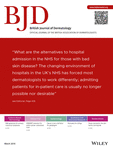

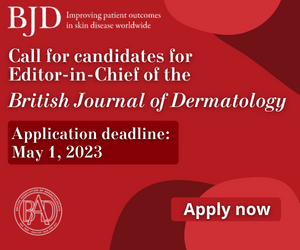
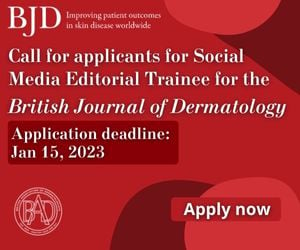

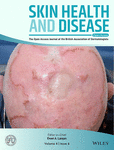
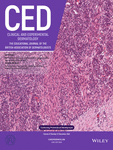
2690-442X.cover.png)